The 3 Best Bilge Cleaners 2024
Best Overall Choice

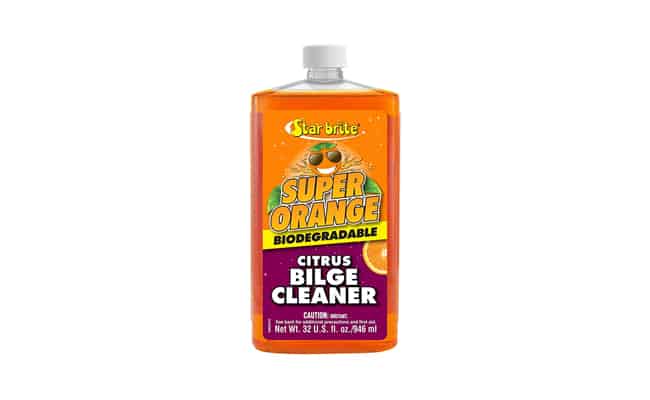
Star Brite Super Orange Citrus Bilge Cleaner
Best Budget Choice

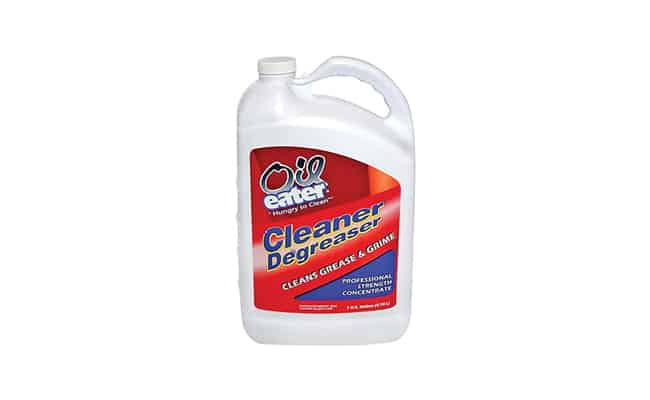
Oil Eater Cleaner Degreaser
Best Premium Choice

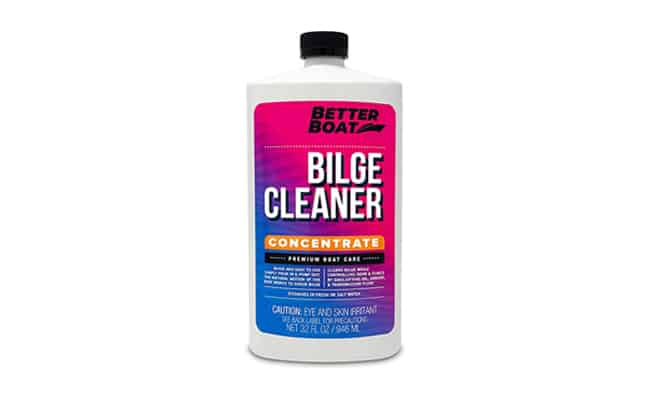
Better Boat Premium Bilge Cleaner
The bilge on a boat is one of the least respected parts of the craft, despite its importance. As boat owners, we know that we need to clean it regularly, but it happens much less frequently than it should. Consider that if the bilge pump stops working you risk sinking. It makes sense to keep it running cleanly and efficiently.
The history of bilge dates back centuries to the earliest days of boating. Sailors referred to their rubbish or trash talk as bilge. Legend has it that the crew of some ship sent an unknown sailor to inspect the deepest, darkest part of the ship. That was down where the water and residue collect. After a brief time in this black hole, the sailor noted that it was also full of rubbish and trash. From that day on, they referred to the area where water collects in a boat as the bilge.
You typically have two approaches to cleaning your bilge. There’s the DIY method where you can mix up a home brew of dish soap or other cleaners. There’s also the more professional route of using a formulated bilge cleaner. The kind that can emulsify grease and cut through sludge and slime.
Cleaning:
The most important reasons to keep your bilge clean are:
-
to prevent the growth of bacteria
-
cut foul odors
-
prevent rust and corrosion of equipment that lies in the bilge
You can get bilge cleaner in most marine hardware stores, but, it can be expensive. Liquid Tide is less expensive and does as good a job. It contains no phosphorus and is biodegradable. It can also cut grease and dirt, and has a clean smell that makes it a good choice.
There are several commercial cleaners on the market, but they are not all created equally. You need a biodegradable and environmentally-friendly cleaner. Even if you empty the bilge safely, you may still have residue that comes out later and can pollute the water.
Older cleaners use harsh chemicals, abrasives, or acids to clean. You want to make sure you’re also finding a product that won’t damage the various parts of your boat. Make sure you look for ones that state they are safe for fiberglass, plastic, metal, rubber, and so on.
Star Brite Super Orange Citrus Bilge Cleaner
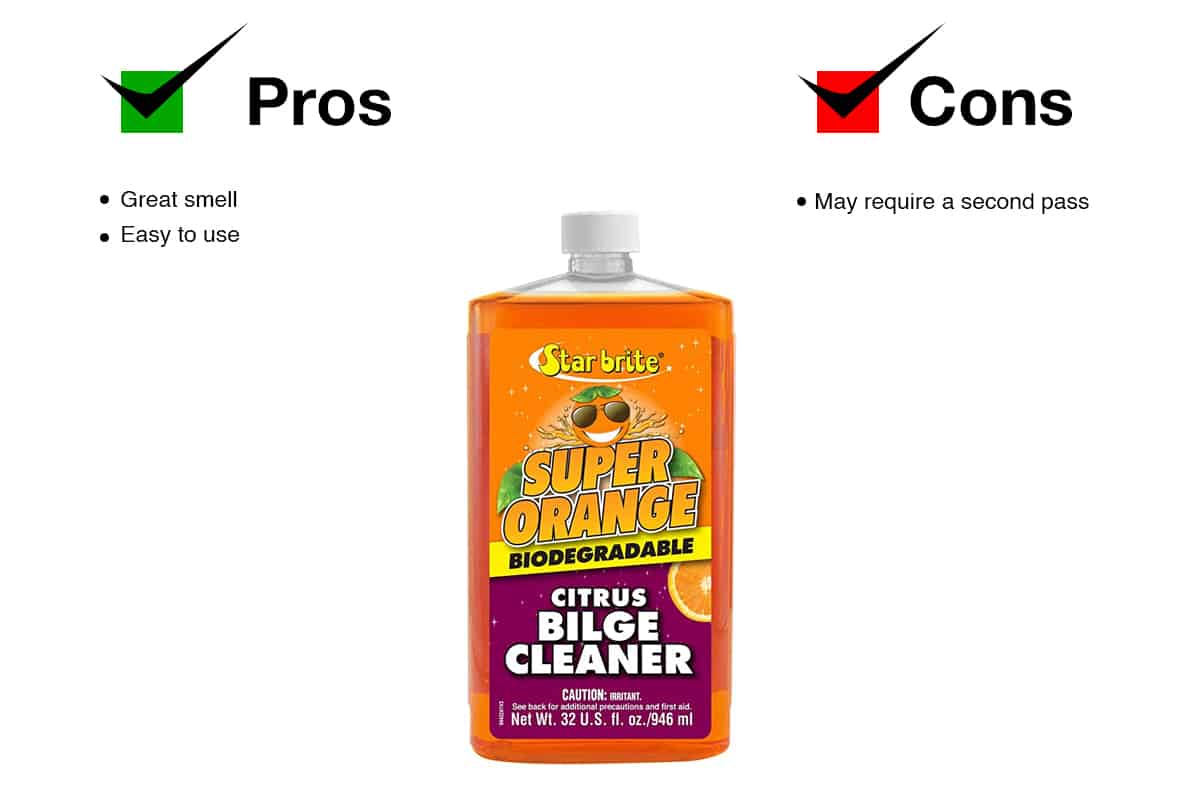
When you’re in the market for a fast and efficient cleaner, Star Brite’s Super Orange is a great choice. Like many household cleaners, it’s made with citrus oil. That means it’s able to emulsify oil, grease and transmission fluid. It also takes on the dirt and sludge built up in your bilge.
One bottle will cover 25 feet of boat length. That means it can easily handle most personal watercraft. It’s also reasonably priced so it won’t break the bank.
Star Brite is one of the best smelling cleaners on the market. That may not seem like much, but you’ll appreciate it when you use it. You don’t want a harsh or chemical smell overpowering you. You also don’t want it to seem like you’re covering up one smell with a different one.
Trying to scrub the bilge yourself is not a simple job. You’ll notice the difference when you use a quality product like this one. Just turn off the bilge pump and drive around in the boat for a little while to let it do the work on its own. Make sure you keep an eye on the water levels in the bilge since the pump won’t be working.
Super Orange is safe for fiberglass and metal and won’t damage plastic wiring or rubber hoses. You still want to avoid getting it on your hands though, as it can irritate skin.
Some customers have struggled to get the most stubborn messes cleaned. That said, most reviews of Super Orange are favorable.
If you haven’t cleaned your bilge recently, you will need multiple treatments to get a full clean. Likewise, if you picked up a new boat and that hasn’t been well maintained then you’ll need a second bottle.
Make sure you pump the bilge safely after cleaning. Even though this is biodegradable you don’t want to dump the dirty water you’ve cleaned out back into the water. It’s bad for the environment and it’s illegal.
Pros
Great smell
Easy to use
Cons
May require a second pass
Oil Eater Cleaner Degreaser
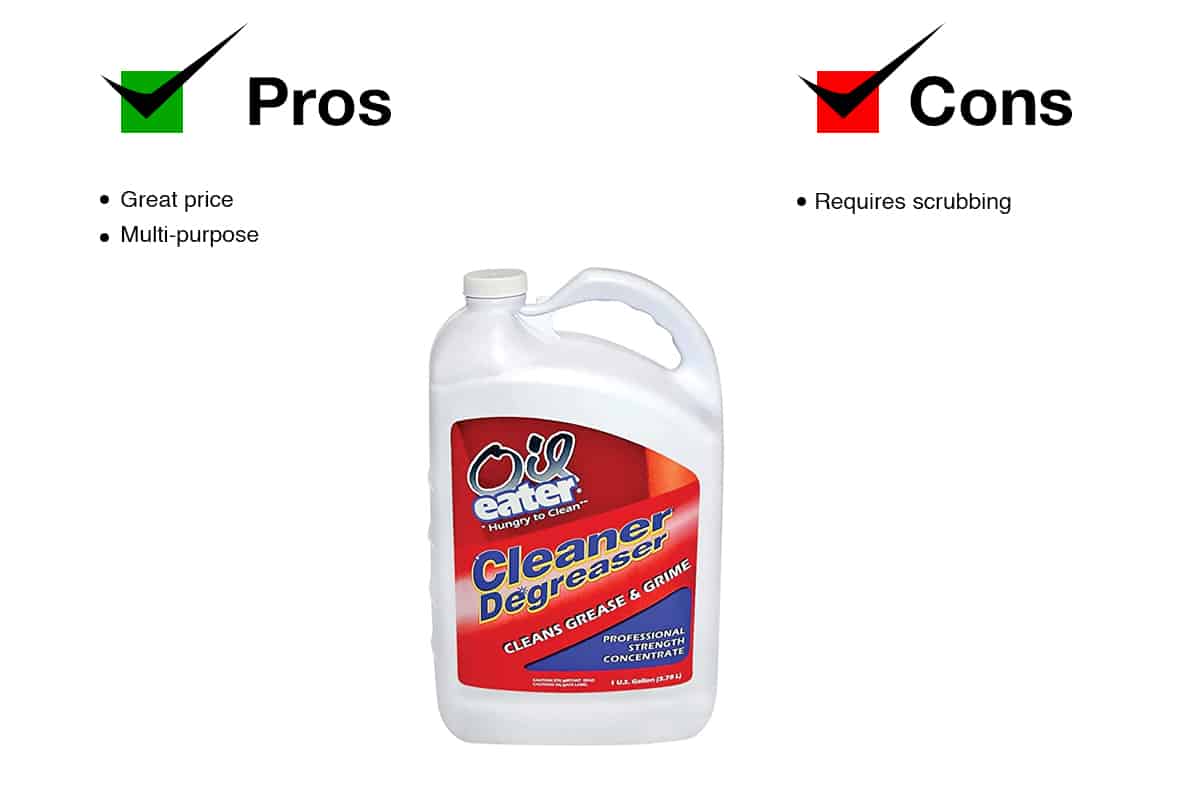
Oil Eater is a multi-purpose cleaner, not just a bilge cleaner. That said, it will show at the top of your Amazon search when you’re looking for bilge cleaners. It’s also recommended by several boat experts online. Because it’s a diverse and multi-use product you may prefer it to bilge-specific cleaners. You’ll likely be able to use it for other jobs.
The uses for Oil Eater are extensive. They range from spot treatment on laundry and carpets to engine cleaning. You can also tackle floors, asphalt, and tools. It’s a non-corrosive formula devoid of acids or petroleum cleaners and is safe for even septic system use.
Even though this product is safe to clean oil from your bilge you can’t legally pump it into the water afterward. You cannot pump any water that may contain enough oil to leave a sheen on the water out into open water.
Oil Eater works best with manual cleaning and a good scrub brush will make the process easier. For bilge cleaning, follow the bottle directions and dilute it to make a 1:1 solution. The company offers a toll-free helpline to call if you need advice on how to use it.
The Oil Eater bottle is larger than some bilge-specific cleaners. But keep in mind the specific dilution for use. We’ve recommended the 1:1 solution that the manufacturer sets out for heavy-duty cleaning. There are no precise instructions on the label for cleaning bilge. That means the level of build-up will affect how you need to clean it.
If your bilge is especially dirty, give their number a call for some expert insight into how best to tackle it.
Pros
Great price
Multi-purpose
Cons
Requires scrubbing
Better Boat Premium Bilge Cleaner
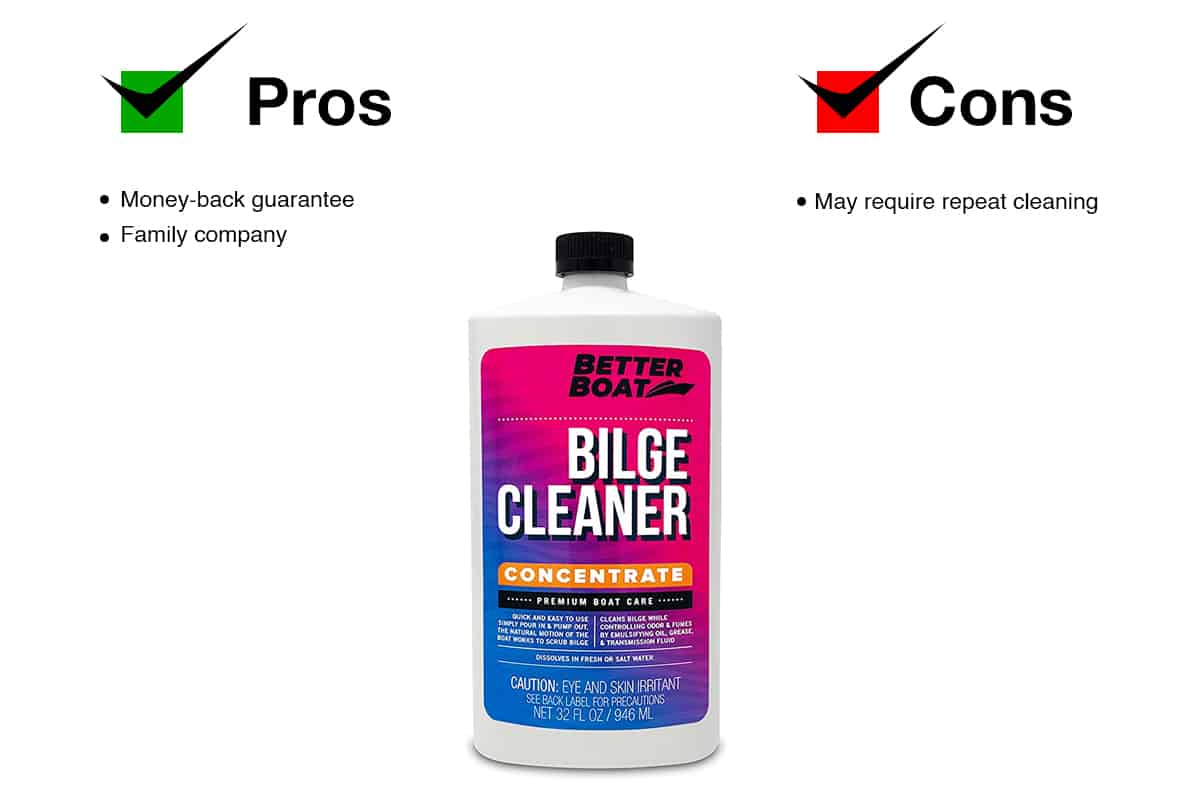
Better Boat’s bilge cleaner comes with a money-back guarantee from the manufacturer. It’s a no-questions-asked full guarantee. Most cleaners claim to handle a tough mess, but Better Boat is putting their money where their mouth is.
The product emulsifies grease and oil. It also cleans out fuel and other substances so you can pump it all out afterward. To start, they recommended you fill the bilge with several gallons of water. Then you need to add one ounce of bilge cleaner for every 3 feet of water line length directly to the bilge water. You should repeat the process to ensure a full clean.
Better Boat recommends cleaning once a month or as needed as maintenance. They also recommend leaving a small amount of bilge cleaner in the bilge all the time to prevent buildup.
Better Boat is a family-owned company based in Miami, Florida. If buying American is important to you, that’s a point in their favor. They offer the same money-back guarantee on all their products. As their website shows they are avid boaters themselves. That means they can use first-hand knowledge and expertise in crafting their products. Does that make a tremendous difference in the formulation of a bilge cleaner? No, but it means that they’ve had the same experiences with boating that you have had.
Pros
Money-back guarantee
Family company
Cons
May require repeat cleaning
Some boats take in more water than others. It is normal for some water to be in the bilge since it can leak in at the stuffing boxes and rudder posts. But, if you find an unusual amount of water, make sure you don’t have a leaking through-hull fitting or pipe. If your boat usually has some water in the bilge, add the liquid Tide to the bilge. From there, let the rocking of the boat do the cleaning for you.
You can remove most grease and dirt can with Tide and a little elbow grease. Steam cleaning can be an alternative. Steam cleaning is a harsh method that can cause the paint to peel, especially on a wooden boat. As they say on the stunt shows, don’t try this at home. Seek out a professional and check their references.
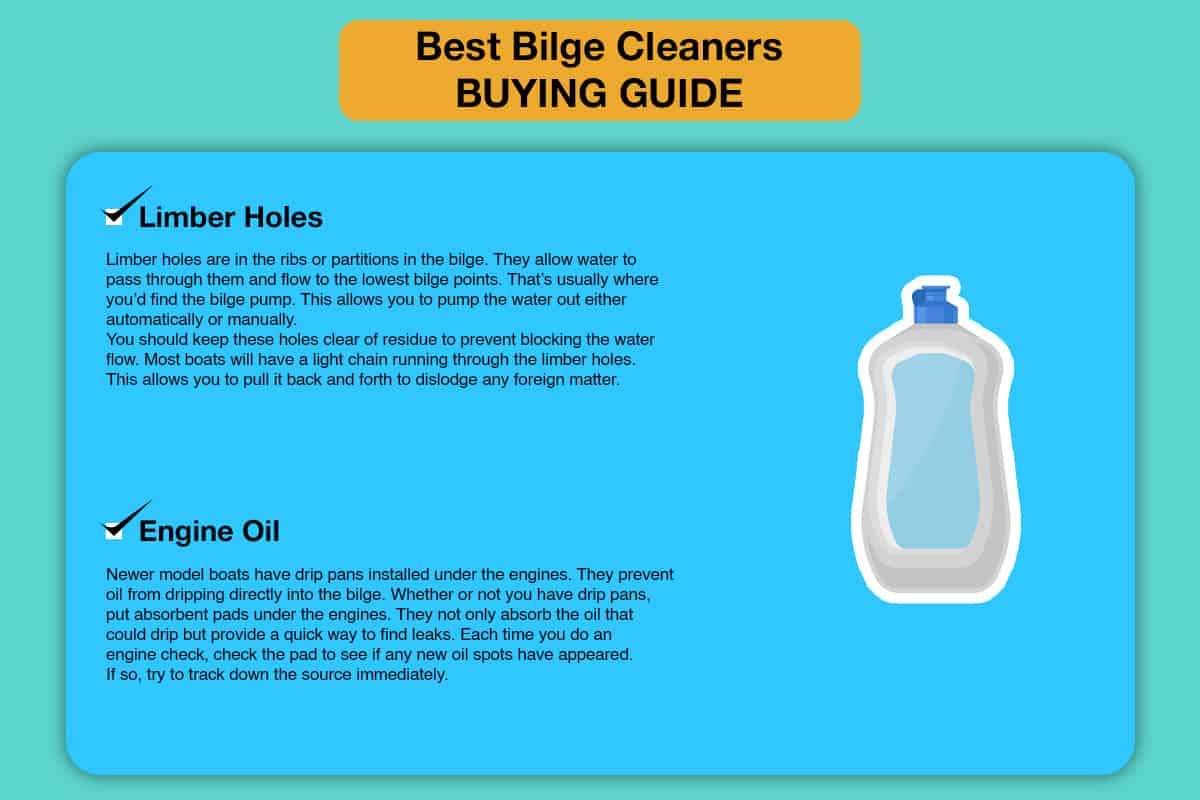
Limber Holes:
Limber holes are in the ribs or partitions in the bilge. They allow water to pass through them and flow to the lowest bilge points. That’s usually where you’d find the bilge pump. This allows you to pump the water out either automatically or manually.
You should keep these holes clear of residue to prevent blocking the water flow. Most boats will have a light chain running through the limber holes. This allows you to pull it back and forth to dislodge any foreign matter.
Engine Oil:
Newer model boats have drip pans installed under the engines. They prevent oil from dripping directly into the bilge. Whether or not you have drip pans, put absorbent pads under the engines. They not only absorb the oil that could drip but provide a quick way to find leaks. Each time you do an engine check, check the pad to see if any new oil spots have appeared. If so, try to track down the source immediately.
What to look for:
You should inspect the bilge and its surroundings with a flashlight at least once a month. Look for the following:
-
Lift up the float switch on your electric bilge pump to make sure it turns on the pump automatically.
-
If you find unusual amounts of water, be sure to track down the source.
-
Check all through-hull openings and fittings.
-
Make sure that all fittings below the waterline have double hose clamps.
-
Check the seacocks to make sure that you can turn them off. You could sink your boat if a hose comes loose from a seacock. This is a real danger if you have a corroded valve and you can’t stop the flow of water.
-
Look for corrosion and rust.
-
Check for unusual growth or mildew.
-
Check all pipes, hoses, and clamps.
-
Check limber holes.
Don’t Pollute:
Remember that it is illegal to pump oily discharge overboard. If you find oil in your bilge water turn off the bilge pump and find an alternative way of disposing of the oily water. Don’t think just because there is only a little bit of oil it is okay. The test for illegal pollution is simply a “visible sheen” on the water.
Categories: nauticalknowhow, Reviews











